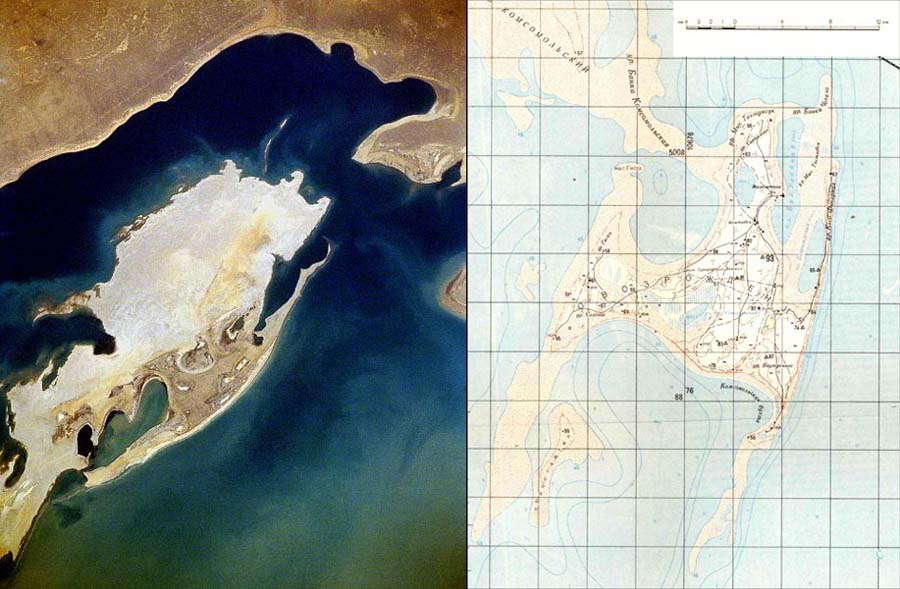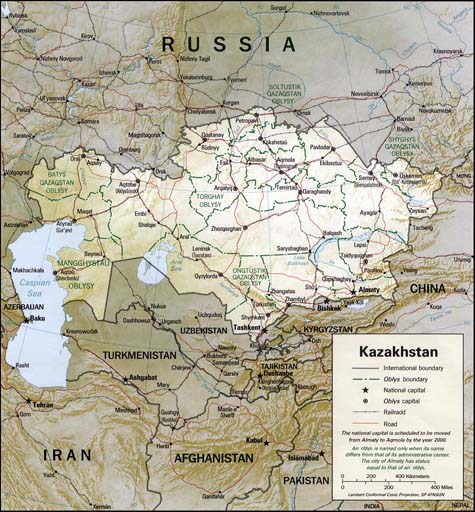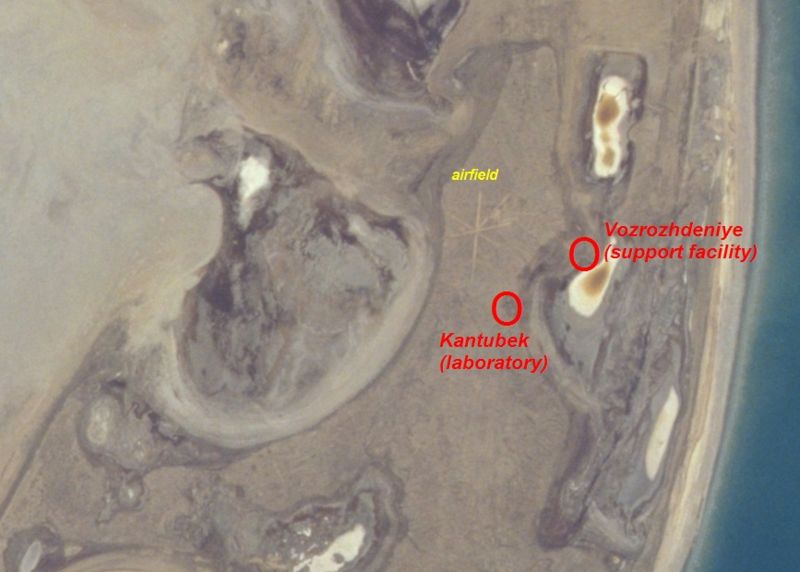The Island of Forgotten Diseases
 [Images: Vozrozhdeniya Island, via Wikipedia].
[Images: Vozrozhdeniya Island, via Wikipedia].On the desolate central Asian island of Vozrozhdeniye – or Vozrozhdeniya – near the south rim of the shrinking Aral Sea, you'll find "the remains of the world's largest biological-warfare testing ground."
As The New York Times reported back in 2002, for nearly four decades Vozrozhdeniye Island was "a practice field for the most hideous kind of warfare."
The whole site is now abandoned.
 Amidst "hundreds of cages designed to hold guinea pigs, hamsters and rabbits," the New York Times continues, the old Soviet germ labs lie in ruins:
Amidst "hundreds of cages designed to hold guinea pigs, hamsters and rabbits," the New York Times continues, the old Soviet germ labs lie in ruins:- A germproof full-body suit, complete with a glass face mask and an airhose attachment in the back, lies in a corner. An odd smell – ether, chlorine and something indefinable – lingers in the air. Poking out of the rubble are dusty issues of The British Medical Journal and The Journal of Infectious Diseases.
It is all surprisingly low tech: nails are everywhere, but no screws. There are books by Marx and Lenin and yellowed, handwritten ledgers that would not seem out of place in a museum devoted to a 19th-century Russian writer.
In fact, we're told, the "only access to the island now is in the company of the scavengers, who say they began stripping the island bare back in 1996." They've now stolen "everything from floorboards to wiring," and have begun "working on galvanized-steel piping, sealed and towed at a snail's speed to the mainland shore."
The real – and much more pressing – question seems to be: what else will these scavengers find on Vozrozhdeniye Island?
- When they arrived for last year's toil, in July, the scavengers discovered that an official U.S.-Uzbek expedition had come earlier in the year and burned down a row of eight warehouses. But much of the contents of the warehouses survived the blaze, including a vast array of test tubes, bottles and petri dishes, some still in their original wrapping. The fire left some half-melted, looking like figures in a Dalì painting, but most are intact underneath a coat of dust.
- Further on, four poles have been set horizontally on pickets two feet from the ground. Rusty chains hang down, even a few feed troughs. This is where the horses and donkeys were tied up. You can imagine them standing patiently in a row at dusk, when the wind would ease and deadly aerosols would be released.
At the highest point on the island, a 40-foot observation tower stands near the foundations of a gutted building. A spindly radio antenna still soars. It was a weather station. From the top of the tower, six dirt roads can be seen stretching in various directions to other test sites.
It is all very spare and quiet. The scavengers are silent, too.
Bubonic plague, the article quietly notes, already "affects a handful of people each year in Central Asia."
It's here that the ongoing risks of the site are made clear: "if a scavenger contracts the plague and makes it to a hospital, he could start an epidemic."
Worse, Vozrozhdeniye Island is now attracting representatives of the oil industry – who have begun to perform some exploratory drilling. What might they really dig up...?
 [Image: An aerial view of Kantubek, an abandoned town on Vozrozhdeniye Island; via Wikimedia].
[Image: An aerial view of Kantubek, an abandoned town on Vozrozhdeniye Island; via Wikimedia].The implied storylines here for future science fiction, or horror, films is totally out of control – and yet there is still more to learn about Vozrozhdeniye Island.
For instance: it's no longer really an island.
The Aral Sea, in which Vozrozhdeniye sits, has been evaporating since the 1980s, due to catastrophically mismanaged Soviet irrigation plans – which means that Vozrozhdeniye is now a peninsula.
This otherwise unremarkable geographical shift has frightening implications:
- Many of the containers holding the [biowarfare agents] were not properly stored or destroyed, and over the last decade many of the containers have developed leaks. As the Aral Sea continues to recede, the area will eventually connect further with the surrounding land. Many scientists fear that animals will move to the surrounding land and eventually carry these deadly biological agents out.
According to "a previously secret Soviet medical report," which included "autopsy reports, pathology reports, containment tactics, and an official Soviet analysis of the outbreak's source," there were 10 cases of smallpox reported in Aralsk alone – after which "officials quarantined the city for weeks."
In the process, "Homes and belongings were decontaminated or burned."
Potential novelists or screenwriters might want to start paying attention here, though, because this is a near-perfect plot device.
- The person believed to have introduced the virus to Aralsk was a young female ichthyologist who had just returned from a four-week research expedition on the Aral Sea aboard the Lev Berg, a small fishing boat. According to official documents, she was bed-ridden with a fever, headache, and muscle aches aboard the ship beginning Aug. 6, five days before returning to Aralsk on Aug. 11. Before public health officials diagnosed smallpox as the cause of her illness six weeks later, the young woman had exposed her nine-year-old brother, who had exposed others.
You can read more about the outbreak at the website of Sandia Labs.
Finally, there was even speculation, back in 2001, that Vozrozhdeniye Island may have been distantly involved in the U.S. anthrax attacks.
But I could go on and on. If you want to know more, though, just follow the links, above, or check out CNN – and, if you're a budding novelist, and you decide to go somewhere with this material, let me know!
And if you're anywhere near the Aral Sea, beware the wind...
(Thanks to Neddal Ayad for pointing Vozrozhdeniye Island out to me!)





Comments are moderated.
If it's not spam, it will appear here shortly!
Vozrozhdeniya Island is so great as the story of two hypermodernist Big Projects colliding in the most unexpected ways.
No one ever thought, 'Hey we should get these desert irrigation guys and these bioweapons guys together in the same room sometime, just to like, make sure we're all on the same page!'
Combine the desire to control unpredictable systems like germs and water with a mania for secrecy and compartmentalization; unintended consequences are almost inevitable ...
Great writeup, Geoff, thanks for the shoutout!
No problem - thanks for the NYTimes link.
Just to prove that no matter what we put in our fictions, reality tends to be wilder than expected...
Great post (yet another one).
that's just insane. wow. you're right, that's so the next horror film!
Dear god, that's some nice nightmare fuel, there.
Although I would love to see this place, I feel safer knowing that the closest I'm going to get to it next month is Samarkand.
That us some scary stuff. Just hope there isn't a real pandemic. There could be anything on that island,like Nova 6
that place will probably be the death of us all.
Post a Comment